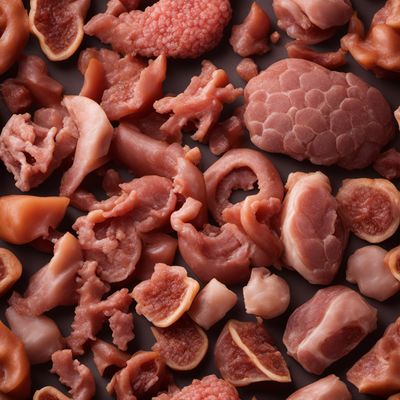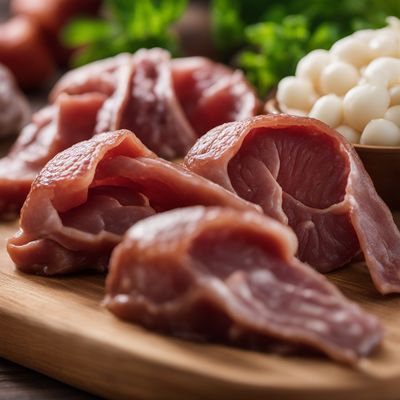
Ingredient
Rabbit edible offal, non-muscle, other than liver and kidney
Unveiling the Hidden Gems: Exploring the Versatile Rabbit Edible Offal
Rabbit edible offal, non-muscle, other than liver and kidney, encompasses various organs such as the heart, lungs, spleen, and more. These offal cuts possess distinct characteristics, with the heart being tender and slightly gamey, the lungs offering a delicate texture, and the spleen providing a rich and earthy flavor. Their appearance varies, with the heart resembling a small muscle, the lungs having a spongy texture, and the spleen appearing as a dark, elongated organ. When cooked properly, rabbit offal can add depth and complexity to a wide range of dishes.
Origins and history
Rabbit offal has a long history in culinary traditions around the world. It has been consumed for centuries, particularly in European and Mediterranean cuisines. In many cultures, offal was highly valued as a way to utilize the entire animal and minimize waste. Today, rabbit offal continues to be appreciated for its unique flavors and versatility in various traditional and modern dishes.
Nutritional information
Rabbit offal is a nutrient-dense ingredient, rich in protein, vitamins, and minerals. It provides essential nutrients such as iron, zinc, and vitamin B12, while being relatively low in calories.
Allergens
Rabbit offal may pose allergenic risks to individuals with a known allergy to rabbit meat or other offal products. It is important to exercise caution and consult with a healthcare professional if you have any concerns.
How to select
When selecting rabbit edible offal, non-muscle, other than liver and kidney, look for cuts that are fresh, firm, and free from any unpleasant odors. The offal should have a vibrant color and appear moist but not slimy. Additionally, choose offal from reputable sources to ensure quality and safety.
Storage recommendations
To maintain the freshness and quality of rabbit offal, store it in airtight containers or sealed plastic bags in the refrigerator. Use it within 1-2 days for optimal flavor and texture. If you plan to store it for a longer period, consider freezing the offal in suitable freezer bags or containers for up to 3 months.
How to produce
Producing rabbit edible offal requires specialized knowledge and expertise. It is recommended to consult with a professional rabbit farmer or butcher who can guide you through the process of raising rabbits and properly harvesting the offal.
Preparation tips
Before cooking rabbit offal, it is essential to clean and trim any excess fat or connective tissue. The offal can be marinated to enhance its flavors or simply seasoned with salt and pepper. Cooking methods such as grilling, sautéing, or braising work well with rabbit offal, allowing it to develop a tender texture and rich flavors. Incorporate it into stews, terrines, or pâtés for a delightful culinary experience.
Culinary uses
Rabbit edible offal, non-muscle, other than liver and kidney, can be used in various culinary applications. It adds depth and complexity to stews, soups, and sauces, or can be incorporated into terrines, pâtés, or sausages for a unique twist. The heart can be grilled or pan-seared as a standalone dish, while the lungs and spleen can be used in traditional recipes such as haggis or as fillings for dumplings.
Availability
Rabbit edible offal, non-muscle, other than liver and kidney, is commonly available in regions where rabbit meat is consumed, including Europe, North America, and parts of Asia.
More ingredients from this category

Deer edible offal, non-muscle, other than liver and kidney
The Hidden Gems of Deer: Exploring Non-Muscle Edible Offal

Pig edible offal, non-muscle, other than liver and kidney
Beyond the Ordinary: Exploring the Versatility of Pig Edible Offal

Camel edible offal, non-muscle, other than liver and kidney
Unveiling the Hidden Gems: Exploring the Exquisite Camel Edible Offal

Goat edible offal, non-muscle, other than liver and kidney
The Hidden Gems of Goat: Exploring the Delicacies of Edible Offal

Wild boar edible offal, non-muscle, other than liver and kidney
Savory Treasures from the Wild

Sheep edible offal, non-muscle, other than liver and kidney
Exploring the Delicacies of Sheep Edible Offal

Bovine edible offal, non-muscle, other than liver and kidney
The Hidden Gems of Bovine Offal

Equine edible offal, non-muscle, other than liver and kidney
Exploring the Hidden Gems of Equine Edible Offal